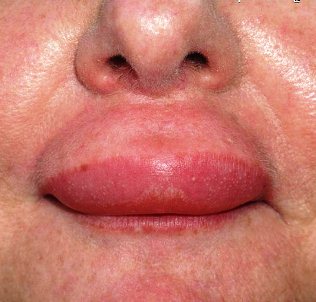
Angioedema
Angioedema is a skin reaction similar to hives or urticaria. It is most often characterised by an abrupt and short-lived swelling of the skin and mucous membranes. All parts of the body may be affected but swelling most often occurs around the eyes and lips. In severe cases the internal lining of the upper respiratory tract and intestines may also be affected.
Classification- Acquired angioedema (AAE) can be immunologic, nonimmunologic, or idiopathic.- Hereditary angioedema (HAE) exists in three forms, all of which are caused by a genetic mutation inherited in an autosomal dominant form. They are distinguished by the underlying genetic abnormality.-
Peripheral swelling: skin and urogenital area (e.g., eyelids or lips, tongue, hands, feet, scrotum, etc.)
-
Abdomen: Abdominal pain (sometimes it can be the only presenting symptom of angioedema)
-
Larynx: Throat tightness, voice changes, and breathing trouble (indicators of possible airway involvement), potentially life-threatening.
Several medicines may help prevent or relieve attacks. For mild cases, you can use over-the-counter antihistamines, such as Benadryl, Zyrtec, Allegra, or Claritin. Note that Benadryl often causes drowsiness.
- Complementary and Alternative Therapies
- Nutrition and Supplements

